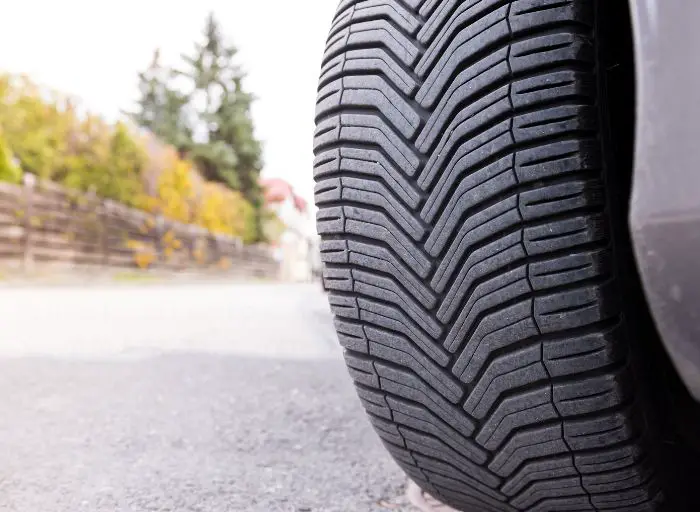
Every year at the changeover from winter to spring or from fall to winter, it’s time to change the tires. Many would like to save the costs and the appointment in the workshop – as well as the expenses for the second set of car tires. But which tires should you choose? All-season tires seem to be both a way out and a solution in this case. But can you also drive your summer tires in winter? Are there summer tires that are also approved for winter use? For which driving behavior do all-season tires represent an alternative?
Table of Contents
Why Drive Summer Tires in Summer and Winter Tires in Winter?
In order to be able to exercise the highest possible control over the vehicle, even in difficult road conditions, the tires are crucial. Since the temperature of the road surface directly affects the load-bearing capacity of the car tire and poses major challenges, there are appropriate rubber compounds for both temperature extremes. High temperatures present the tire with completely different challenges than snow or slippery tires, for example.
To ensure the best possible grip and precise steering even at high temperatures in summer, summer tires use a significantly harder rubber compound than winter tires. As a result, they retain their structural integrity even with increased friction and on heated roads. Furthermore, the difference between summer tires and winter tires lies in the tread structure: Unlike winter tires, summer tires have a uniform structure that serves to drain rainwater from the tire.
Summer Tires in Winter: Under What Conditions Is It Allowed?
If summer tires are driven in winter, the rubber compound is too hard to provide the necessary traction. In addition, the tread, which is also designed for wet roads, adheres significantly worse on icy roads. This is why there has been a situational winter tire requirement in Germany since 2010.
In concrete terms, this means that in Germany, winter tires are mandatory on vehicles not during a specific period but in certain weather conditions. These include “black ice, slush, frost or icy roads.” Drivers who drive with summer tires under these conditions are liable to prosecution and also endanger themselves and their passengers.
But can you also drive your winter tires in summer?
The reverse is not true: if you want to drive with winter tires in summer, you are free to do so. However, in this case, you should also weigh up whether you really want to drive winter tires in summer. We tell you which arguments are in favor and which are against.
Driving winter tires in summer: Is that allowed?
If drivers decide to drive their winter tires in the summer, there is often a particular reason for doing so: economy. Whether it makes sense to drive the winter tires beyond the winter also in the summer out of thriftiness, is first of all debatable.
Does It Make Sense to Drive Winter Tires in Summer?
The law does not prohibit the use of winter tires in summer. However, the same applies here as to summer tires: the rubber compound and the structure of the tire tread are designed for specific temperature ranges. An increased rubber content in winter tires guarantees a strong grip even at low temperatures and prevents stiffening of heavily stressed tread areas.
In summer, on the other hand, temperatures demand just that. If winter tires are driven in summer, the driving behavior becomes much less reliable. It is the same as with underinflated tires: the vehicle does not sit securely on the road and rides “spongily.”
If the remaining tread depth is also borderline, the driver also runs the risk of having to contend increasingly with aquaplaning on wet surfaces. The tire treads are often worn to such an extent that excess water can hardly be removed from the tire. Together with the softer rubber compound of the tire, this leads to significantly longer braking distances: If the tire is too soft, it gives way more during braking.
The energy released during braking is transferred directly to the tire instead of the brake pads. At a speed of 100 km/h, the braking distance is often 16 meters longer than with a summer tire, according to the ADAC. In addition, due to the softer rubber compound, the contact area of the tire on the road is significantly higher and additional energy is required for this.
The result is higher fuel consumption than summer tires. Depending on the distance to be covered, the economic driver on winter tires in summer ultimately pays more for gasoline than the driver on summer tires.
When Can Driving All-Season Tires Be an Alternative?

Drivers who live in a region of Germany where snow falls only sporadically in winter or who primarily use their vehicle in urban traffic are often inclined to drive only one set of car tires throughout the year. However, as listed above, in this case, neither a summer nor a winter tire should be chosen since driving on summer tires in winter is punishable in winter conditions, and winter tires in summer can only meet the requirements for suitable tires to a limited extent.
Here it is obvious to choose an all-season tire (also: all-weather tire). In the meantime, a large number of manufacturers offer car tires that can be driven all year round and thus promise an “all-season solution.” But when all-season tires or all-weather tires are actually an alternative depends on various factors.
Since January 1, 2018, all all-weather tires produced, just like winter tires, must display the snowflake symbol (or: 3PMSF). This symbol guarantees motorists that the manufacturer’s tire meets the requirements of the European market. The rubber compound of all-season tires is designed for both mild winter days and cool summer days.
This means that all-season tires are neither as soft as winter tires nor as hard as summer tires. They are, therefore, a compromise of both types of tires. You should always be aware of this because, for this reason, all-season tires naturally do not offer the same performance at both temperature extremes as the corresponding special tires. One thing that makes all season tires considerably less desirable to use during summer months is the fact that they tend to be noisier than ones made specifically for summer months. But to be honest the convenience may be worth it still for a lot of people.
For Which Driving Conditions Do All-Season Tires Represent an Alternative?
If corresponding weather extremes occur only rarely in your region or if you mainly drive in city traffic, all-weather tires may be an alternative. The only thing to keep in mind is that the special rubber compound of all-season tires is subjected to greater stress than that of winter tires (in winter) and summer tires (in summer). Thus, with all-season tires, it will be necessary to change them more often.
Hi there! I’m Naomi O’Colman. I’ve got years of experience working at an auto repair shop here in Texas under my belt. On top of that, ever since I was a kid I’ve been passionate about the auto industry. Since I’ve joined the team at automotivegearz.com I’ve been enthusiastically sharing my passion and insights with my readers. I’m dedicated to delivering high quality content and helping you stay up to date with the latest automotive trends and products out there!







